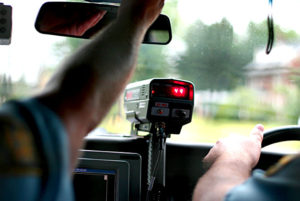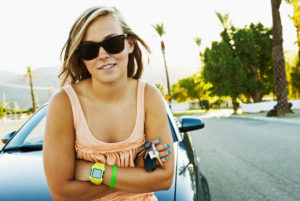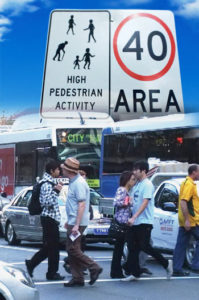1. Why has this new rule being introduced?
This rule was introduced to improve the safety of police and emergency workers, as well as the people they are protecting. The new rule provides certainty for motorists about how they should behave when emergency vehicles are stationary on the road and displaying blue or red flashing lights.
2. What are the key features of the new rule?
The new rule requires that motorists must not exceed 40km/h when passing a stationary emergency vehicle displaying flashing blue or red lights. Motorists must also give way to any person on foot near an emergency vehicle displaying flashing lights and not increase speed until a sufficient distance past the vehicle.
The new road rule will not apply when an emergency vehicle displaying blue or red flashing lights is on the opposite side of a road separated by a median strip.
3. How should I slow down safely to comply with the new road rule on a high speed road?
Motorists should always start slowing down in a controlled manner as soon as they first see blue or red flashing lights, taking into account the current road conditions including surrounding vehicles.
If an emergency vehicle is attending an incident in an area of low visibility, due to the location or weather conditions, it will be because there are no other options to move to a safer location. Further care should be taken in these circumstances.
The traffic and safety impacts of the rule will be monitored during the first 12 months and the implementation of the rule will be independently evaluated.
4. Why do motorists need to slow down to 40km/h?
40km/h is considered a safe speed around vulnerable road users. This speed is consistent with speed limits in:
5. What is considered a sufficient distance past the vehicle?
The new rule will require that motorists do not increase their speed until a sufficient distance past the emergency vehicle so as not to cause a danger to any person near the vehicle.
For example, a fire truck may be stationed by the roadside with flashing lights and firefighters may be managing a fire a short distance away from the vehicle. In this instance, motorists should not increase their speed until they are fully past the vehicle and the emergency workers. In contrast, motorists will be required to slow down to 40km/h for a shorter distance when passing a police vehicle that has pulled over another vehicle on the side of the road.
It is the responsibility of all drivers to be aware of the individual circumstances of each roadside incident and to drive at a safe and appropriate speed under the speed limit.
6. Does the new rule apply on all road types?
Yes, it applies to all roads, including motorways, highways and freeways. If there is a median strip between your vehicle and the stationary emergency vehicle you will not need to slow down. If the emergency vehicle is on the median strip then the rule will apply to vehicles on both sides of the road.
7. What is a median strip?
A median strip is an area or structure that separates vehicles travelling in opposite directions. A median strip can be covered in grass, it can include or be a wire rope or concrete barrier or be a continuous painted island filled with diagonal bars.

A median strip does not include double white lines, a single white line or a broken white line on its own or in combination with a continuous white line. It also does not include wide centre lines or short painted islands typically found as part of intersection turning lanes.

8. What types of vehicles are covered by the new rule?
Motorists must slow down to 40km/h when passing the following emergency vehicles when stationary and displaying flashing blue or red lights:
- NSW Police Force vehicles
- Ambulance Service of NSW vehicles
- Fire & Rescue NSW vehicles
- State Emergency Service vehicles
- Rural Fire Service vehicles
- Volunteer Rescue Association vehicles
- Traffic Emergency Response vehicles
9. What is the penalty for not obeying this new road rule?
A $448 fine and three demerit points will apply for motorists who do not comply with the new road rule. A maximum court penalty of $2,200 will also apply. This is comparable with the current penalty when it is determined that a motorist has driven negligently in the presence of obstructions or hazards, including stopped emergency vehicles and personnel.
10. What is the government doing to educate motorists about the new rule?
Transport for NSW, with the support of emergency service agencies and other stakeholders, launched a community education campaign across NSW on 30 July 2018 to give the community time to understand the requirements of the rule. The campaign includes TV and radio advertising, social media promotion and digital signage on major roads.
11. Don’t motorists already slow down if they see a vehicle with flashing lights ahead?
The new rule establishes a required standard for safe behaviour and further ensures emergency workers can do their work without worrying about being struck by a passing vehicle. The rule has been designed to provide maximum safety benefits to emergency workers while keeping it simple for the community to understand.
12. Why is there a 12 month trial?
This will allow an evaluation of the safety impacts and any other consequences of the new rule, and enable consideration of reviews and outcomes from other jurisdictions implementing similar rules.
13. How will the new rule be evaluated?
The NSW Government will monitor the safety and traffic impacts of the rule in the 12 months the trial is running, in consultation with key stakeholders, as part of an independent evaluation to determine the impact on the safety of emergency service workers and drivers.
In addition to the safety impacts of the new rule, the evaluation will look at what impact the trial has had on driver awareness of the law and community attitudes, as well as any unintended consequences. It will also consider reviews and outcomes from other jurisdictions implementing similar rules.
14. Who will lead the evaluation?
The evaluation will be led by Transport for NSW in close consultation with NSW Police, emergency service organisations and stakeholder groups. The findings of the evaluation will inform the Government’s consideration about what if any further changes should be made to the rule and how its implementation could be improved to better achieve road safety outcomes, including whether it should apply to drivers when passing other vehicles which display flashing lights, such as tow trucks and motor breakdown service vehicles.






